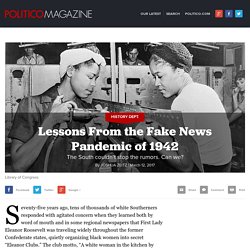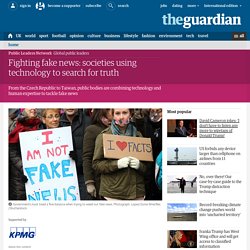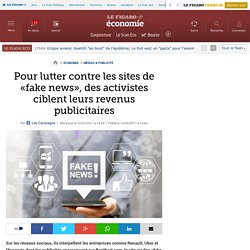

Lessons From the Fake News Pandemic of 1942. Seventy-five years ago, tens of thousands of white Southerners responded with agitated concern when they learned both by word of mouth and in some regional newspapers that First Lady Eleanor Roosevelt was traveling widely throughout the former Confederate states, quietly organizing black women into secret “Eleanor Clubs.”

The club motto, “A white woman in the kitchen by 1943,” portended a dangerous inversion of the region’s longstanding racial patterns. It was already widely believed in the South that black men had been brazenly stockpiling ice picks, pistols, rifles and explosives in anticipation of a larger race riot. With millions of white men now serving in the armed forces and stationed away from their families, the story went, white communities were vulnerable to an impending assault.
When that day came, black women—many of whom worked in domestic service—intended to force their white employers to cook and clean for them. Story Continued Below Of course, none of this was true. Les mille et une ruses de l’industrie de la désinformation. Enquête sur des méthodes employées par des sites trompeurs pour diffuser de fausses informations sans se faire prendre.

LE MONDE | • Mis à jour le | Par Adrien Sénécat Les fake news qui circulent massivement en ligne ne tombent pas du ciel. L’examen détaillé de certaines de ces rumeurs par Les Décodeurs à l’occasion du lancement du Décodex montre que les artisans de la propagande déploient des méthodes de plus en plus ingénieuses. 1. Avancer masqué. Deux fabricants non repentis de fake news s’expliquent. Gros malaise, mais aussi forte curiosité, mardi dans l'immense salle de conférence du Festival South by Southwest à Austin, quand Yasmin Green, directrice de Jigsaw, un des labs d'innovation de Google, a longuement interrogé deux anciens fabricants populaires --et non repentis-- de "fake news" sur leurs pratiques et leurs motivations.

Jestin Coler et Jeffrey Marty. Deux Américains, âgés d'environ 35/40 ans. Le premier, motivé surtout par le remboursement de son prêt immobilier (mais aussi visiblement par le fun); le second, juriste et soutien de Trump, pour faire bouger les lignes d'un "établishment" qu'il exècre. Jestin Coler a fondé Disinfomedia, qui a édité le National Report et le Denver Guardian, connu pour avoir publié trois jours avant l'élection une info bidon, vue 1,6 million de fois et partagée 500.000 fois : “FBI AGENT SUSPECTED IN HILLARY EMAIL LEAKS FOUND DEAD IN APPARENT MURDER-SUICIDE”. "Au début c'était pour rigoler entre potes. Fighting fake news: societies using technology to search for truth. Fake news has been accused of influencing election results and giving rise to populist movements.

Is there anything governments - and citizens - can do to fight back? Some interesting responses to the fake news phenomenon are now in place around the world. The Czech government’s interior ministry, for instance, has opened a Centre Against Terrorism and Hybrid Threats in a bid to fight fake news. The centre was set up after 40 Czech language websites emerged containing false stories, predominantly about migrants. Specialists working for the centre are attempting to counter false information via a dedicated Twitter account, as well as a website devoted to communicating the government viewpoint. Of course, there are ethical issues around removing content, so governments must tread a fine balance. Meanwhile, the German government is hoping social media sites and their users will help in the battle against fake news. Community involvement is a common theme in the battle to tackle fake news.
Three challenges for the web, according to its inventor. Today is the world wide web’s 28th birthday.

Here’s a message from our founder and web inventor Sir Tim Berners-Lee on how the web has evolved, and what we must do to ensure it fulfils his vision of an equalising platform that benefits all of humanity. This letter is also available en français, en español, em português and بالعربية. Today marks 28 years since I submitted my original proposal for the world wide web. I imagined the web as an open platform that would allow everyone, everywhere to share information, access opportunities and collaborate across geographic and cultural boundaries. In many ways, the web has lived up to this vision, though it has been a recurring battle to keep it open. 1) We’ve lost control of our personal data The current business model for many websites offers free content in exchange for personal data.
This widespread data collection by companies also has other impacts. 2) It’s too easy for misinformation to spread on the web Sir Tim Berners-Lee. Pour lutter contre les sites de «fake news», des activistes ciblent leurs revenus publicitaires. Sur les réseaux sociaux, ils interpellent les entreprises comme Renault, Uber et Monoprix dont les publicités apparaissent sur Breitbart.com, le site roi des «fake news».

Leur but: que les annonces soient retirées, créant un important manque à gagner pour ces producteurs d'informations falsifiées. Ils se sont baptisés «Sleeping Giants», les «Géants endormis», d'après une expression anglophone qui recommande de ne pas «réveiller le géant» au risque de graves conséquences.